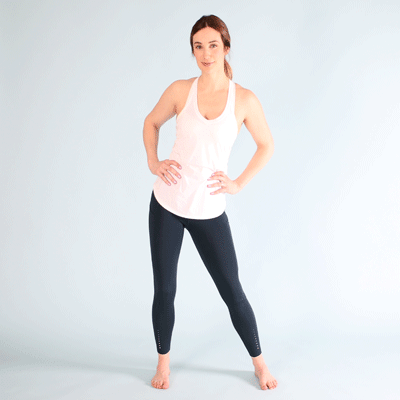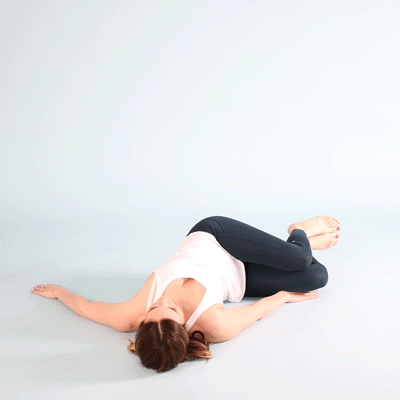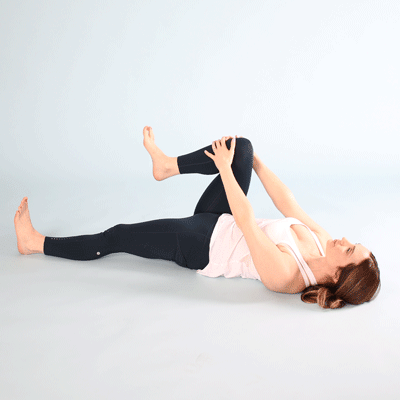Exercises, yoga poses, and stretches may help relieve tightness in your lower back by increasing flexibility and strength. You can do these lying down, sitting, standing, or kneeling.
A tight lower back may affect your daily movements and impact your quality of life.
Sometimes, lower back tightness is also accompanied by symptoms like pain, spasms, and cramping that could affect your pelvis, hips, and legs.
Stretches and exercises can help improve flexibility and strength in your lower back. They can also lengthen and extend your spine, helping to relieve compression in the lower back.
Here are nine exercises you can add to your daily routine.
This exercise increases flexibility, relieves tension, and helps loosen the lower back and hip muscles. If comfortable, you can also engage your core muscles.
Muscles used:
- rectus abdominis (abdominal muscles)
- erector spinae (muscles that run the length of the back)
- pelvic muscles
- gluteal muscles
- Stand with your feet slightly wider than your hips and your hands on your hips.
- Start by gently moving your hips from side to side.
- Slowly rotate your hips in one direction, making big circles.
- Do at least 10 circles.
- Repeat in the opposite direction.
This exercise helps relieve tension and tightness in the lower back and stretches your hips.
Muscles used:
- erector spinae
- sacral muscles (muscles of the part of the spinal column connected to the pelvis)
- pelvic muscles
- obliques
- Lie on your back, bend your knees, and extend your arms out to the side so they’re perpendicular to your torso. Your feet can be a little wider than your hips.
- Exhale as you slowly drop your knees down to the right and turn to look to the left.
- Inhale, returning to the starting position.
- Continue this movement for 1 minute, alternating between the left and right sides.
This stretch helps loosen lower back muscles and increase flexibility while stretching and stabilizing the pelvis.
Muscles used:
- gluteus maximus
- pelvic muscles
- spinal extensors
- quadriceps
- Lie on your back with both legs extended.
- Draw your right knee to your chest with your fingers interlaced around your shin.
- Hold this position for 5 seconds, then release your leg.
- Repeat this stretch 5 times on both legs.
- Draw both knees into your chest and hold your hands, arms, or elbows.
- Hold this position for 30 seconds.
This stretch relaxes the lower back and stretches the hamstrings. It also helps to align the spine.
Muscles used:
- hamstrings
- gluteus maximus
- rectus abdominis
- erector spinae
- Lie on your back with both legs extended.
- Lift your right leg up so it’s as straight as possible, keeping a slight bend in the knee. You can bend your left knee and press into your foot for support.
- Interlace your fingers to hold your leg behind your thigh, or use a strap or towel around the top of your foot.
- Hold this stretch for 30 seconds.
- Repeat on the left side.
- Repeat 2 or 3 times on each side.
This exercise strengthens your lower back and abdominal muscles. It also increases flexibility.
Muscles used:
- hamstrings
- rectus abdominis
- sacral muscles
- gluteus maximus
- Lie on your back with your knees bent. While relaxed, your spine will have a slight curve so the base of your spine isn’t touching the floor.
- Engage your core muscles so the base of your spine presses into the floor.
- Hold for 5 seconds and then relax.
- Repeat 3 times, gradually increasing to 10 repetitions.
This yoga pose increases the flexibility of the spine and provides a nice stretch for your hips and abdomen.
Pay attention to your core muscles as you engage and release them throughout the movement. If you’re feeling especially stiff or sore, try doing the movement slowly and gently.
Muscles used:
- erector spinae
- rectus abdominis
- triceps
- gluteus maximus
- Come into the tabletop position with your weight balanced evenly between all four points.
- Inhale as look up and drop your belly toward the floor.
- Exhale as you arch your back toward the ceiling.
- Continue this movement for at least 1 minute.
This gentle yoga pose relieves pressure on the lower back and helps lengthen, stretch, and align the spine.
Muscles used:
- gluteus maximus
- posterior muscles
- hamstrings
- spinal extensors
- From a kneeling position, sit back on your heels with your knees together or slightly apart. You may place a bolster or pillow under your thighs, chest, or forehead.
- Hinge at the hips to fold forward, extending your arms in front of you, or resting them next to your body.
- Allow your body to fall heavy as you completely relax, letting go of tightness.
- Hold this pose for 1 minute.
This yoga pose allows you to relax your lower back and pelvis. It provides an excellent stretch for your hamstrings and helps relieve stress and tension.
Muscles used:
- hamstrings
- pelvic muscles
- lower back
- back of your neck
- Come into a seated position with the right side of your body against a wall.
- Lie onto your back and swing your legs up along the wall. You may place a cushion under your hips or move your hips a few inches from the wall.
- Relax your arms in any comfortable position.
- Focus on relaxing the lower back and releasing tension.
- Stay in this pose for up to 2 minutes.
Complete your stretching routine with a few minutes of relaxation before going about your day. This gives your muscles a chance to fully relax.
Lie down on your back. Focus on releasing any remaining tension and tightness in the body.
Some natural remedies may help you relieve tightness in your lower back, including:
- heat or ice therapy
- therapeutic massage
- self-massage at home using a foam roller
- acupuncture
- spinal manipulation
- physical therapy
- yoga
It’s important to note that limited research supports these remedies for the treatment of tightness in the lower back. As such, it’s best to speak with a healthcare professional before trying them.
The American Chiropractic Association recommends the following tips to help prevent lower back pain:
- adopt a well-balanced diet
- get regular exercise and warm up beforehand
- avoid being sedentary for too long, such as by walking for 5 minutes every 1 hour
- use a back support when sitting to help improve your posture
- wear comfortable, supportive shoes
- sleep on a firm mattress
- use proper form when lifting heavy objects, such as with your legs instead of your lower back
- quit smoking, if you smoke
Tightness and pain in your lower back may have many different causes, ranging from mild strains to health conditions that require medical attention.
According to the
- sports injuries, such as strains and sprains
- traumatic injury, such as a broken bone
- infections and kidney stones
- pregnancy
- degenerative disc diseases
- herniated disc
- spinal conditions, such as scoliosis, ankylosing spondylitis, and spondylolisthesis
- health conditions, such as myofascial pain, osteoporosis, and cancer
- nerve damage, such as sciatica
You’ll typically see improvements within 2 to 6 weeks of doing daily exercises.
However, you should see a doctor if:
- symptoms affect your daily activities
- symptoms worsen, especially while doing the exercises
- you have a high temperature
- back pain is worse when you cough, sneeze, or laugh
Also see a doctor if you experience any numbness, swelling, or severe pain. They can help determine if any pain or tightness is being caused by an underlying health condition.
How to release lower back tightness?
Several stretches and exercises, including Corpe’s Pose, Child’s Pose, and pelvic tilts, could help release lower back tightness.
Why are my lower back muscles so tight?
Your lower back muscles may be tight for several reasons, such as a strain or sprain, slouching for long periods, a sedentary lifestyle, compensating for other injured body parts like your hamstring or gluteus muscles, or a medical condition.
A tight lower back may affect your ability to perform daily tasks and cause discomfort, pain, and other symptoms.
Some stretches and exercises could help strengthen and loosen your lower back, providing relief.
If your lower back pain doesn’t improve after a few weeks, speak with a healthcare professional. They could develop a treatment plan for you.



